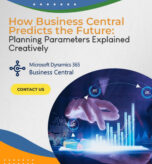
Introduction
Installing Microsoft Dynamics 365 Business Central is not upgrading the system, this is a tactical move towards brighter, more connected business. Migration, however, is typically preceded by delays: data clean-up, user adoption, integration needs, and process optimization. That’s where the Microsoft Power Platform (Power BI, Power Automate, Power Apps, and Power Virtual Agents) comes to the rescue.
Power Platform not only enables your Business Central migration, but it also accelerates it, simplifying the process and bringing value to your business on day one.
Accuracy of financial and operating data in the migration process is a big issue. Power BI enables businesses to:
1. Data Insights with Power BI
Validate data moved through pre- and post-migration reporting.
Compare reports from old ERP to reports from Business Central to detect variations.
Provide executives dashboards that reduce reliance on static Excel reports.
By making Power BI an included native feature of Business Central, decision-makers sense immediate up-to-the-minute insights with migration, knowing the new platform works.
2. Workflow Automation through Power Automate
ERP migrations have a way of exposing inefficiencies in manual workflows. Instead of carrying those inefficiencies with you to Business Central, Power Automate allows you to redesign workflows:
Automate purchase order, invoice, or journal entry approvals.
Notify on update of financial information, like key data.
Swapping e-mail-based manual workflows with traceable automated flows.
Your migration then is not a lift-and-shift, but a genuine process change.
3. Scalability of Functionality with Power Apps
Customizations in older systems can become a real migration challenge. Instead of attempting to replicate it all within Business Central, Power Apps allows you to:
Create lightweight, mobile-optimized warehouse, sales, or field-force apps.
Capture user data and import it into Business Central with minimal coding.
Swap spreadsheets with organized apps that tie in neatly with ERP data.
This saves the expense of customization and enables flexibility during and after migration.
4. Enabling User Adoption with Power Virtual Agents
User adoption is typically the hardest part of any ERP migration. With Power Virtual Agents, you can:
Build chatbots to guide users through new Business Central procedures.
Provide instant answers to “how do I…” type questions.
Reduce IT or support staff dependency while being educated.
By integrating virtual agents into Microsoft Teams, you provide employees with instant guidance as they get up to speed with Business Central.
5. One United Digital Environment
The real power in connecting Business Central to Microsoft Power Platform comes from integration. Instead of separate tools, you have an integrated solution where:
Financials, operations, and reporting are balanced.
People interact with data through Teams, mobile apps, or dashboards.
Your migration forms the basis for lasting digital transformation.
Conclusion
Migration to Business Central isn’t an upgrade to a new ERP, it’s a shift in how your business runs. Through use of Microsoft Power Platform i.e. Power BI, Power Automate, Power Apps, and Power Virtual Agents, businesses can facilitate migration, enhance adoption, and realize near-term business value.
If you’re planning a Business Central migration, don’t overlook the role of Power Platform it’s the accelerator that ensures your investment delivers results faster.







